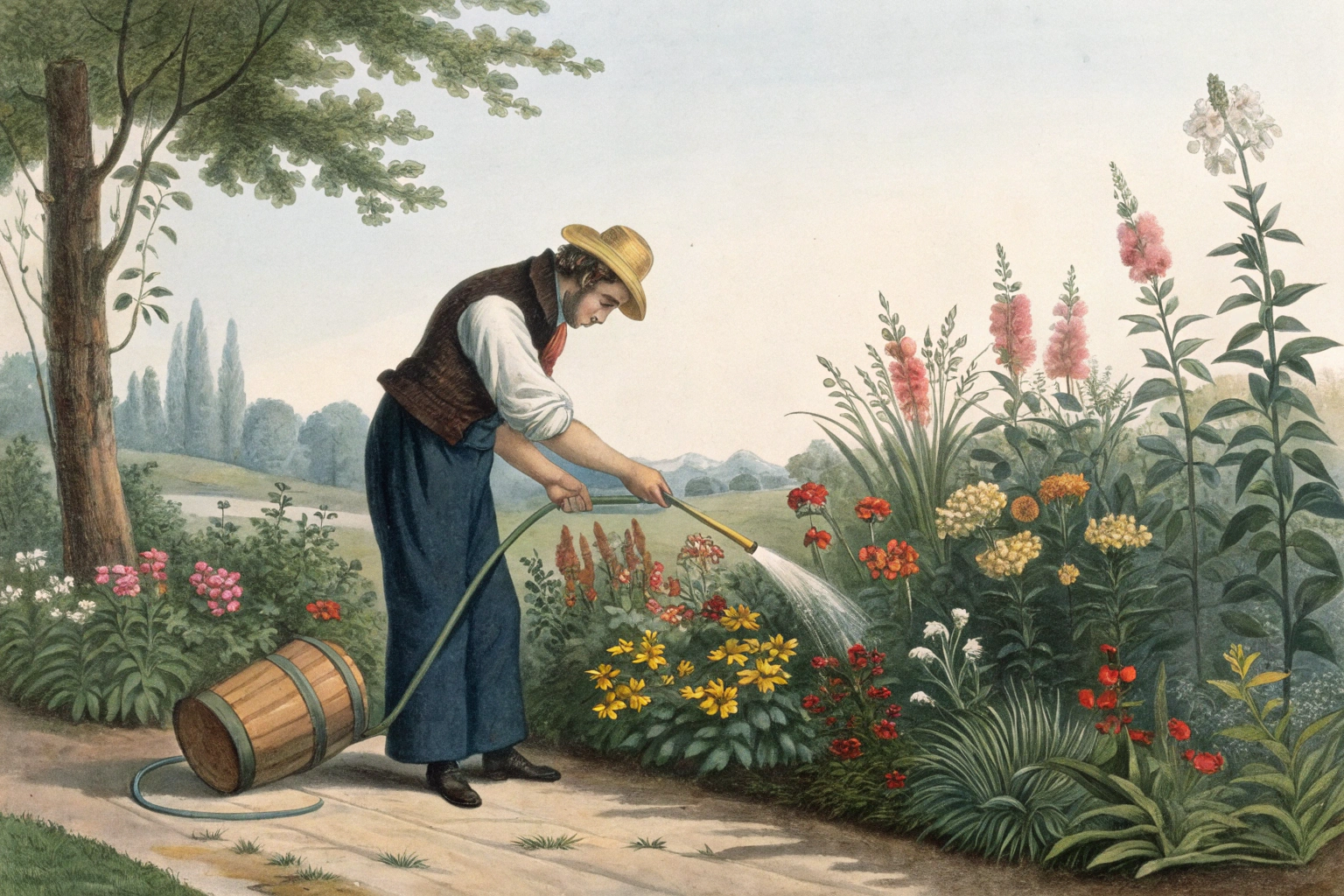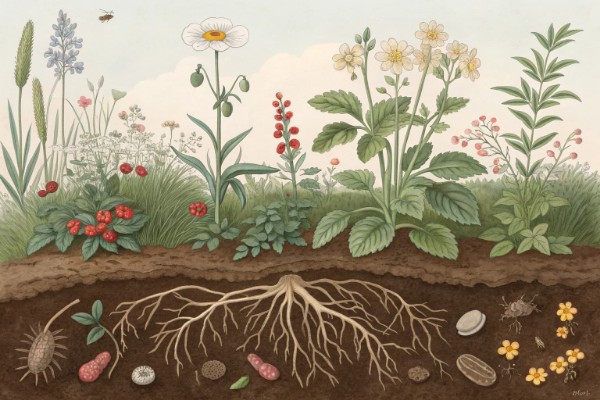Vinegar Weed Killer: Does This Natural Solution Really Work?

Vinegar weed killer
Mix up your own vinegar weed killer to tackle weeds between garden stones, along paths, or bordering vegetable beds. Vinegar weed killer uses acetic acid to dry out leaves on contact, offering a quick fix for visible weeds. A basic vinegar weed killer blend goes together fast with ingredients you already own. Thinking about skipping synthetic sprays for something simple? Keep reading—I'll show you exactly how and where vinegar works best, plus a recipe that actually gets the job done.
Cheatsheet: Quick DIY Vinegar Weed Control
🧪 Tools and products you'll need
- White vinegar (5% acetic acid or higher)
- Optional: Salt (table/rock, 1 tbsp per liter)
- Optional: Dish soap (few drops)
- Spray bottle
- Funnel
- Measuring cup
- Protective gloves
🌱 Quick facts
- 95% of weeds killed after 1-2 applications (acetic acid ≥10%)
- Only works on non-woody, young leaves
- Non-selective: harms all plants it touches
- No soil residue after rain
⚡ DIY weed killer mix
- Pour 1 liter (1 quart) white vinegar into spray bottle
- Add 1 tbsp (15 g) salt (optional for persistence)
- Add 2-3 drops dish soap (breaks surface tension)
- Shake to mix well
☀️ Application tips
- Spray on dry, sunny day (over 68 °F/20 °C)
- Direct mist on weed leaves only
- Avoid roots of desired plants
- Repeat in 2-3 days if needed
💡 Cautions
- Acetic acid irritates skin & eyes
- Avoid runoff into lawns, veggies, water sources
- Repeated use may alter soil pH
🥗 Self-sufficiency boost
- Reduces chemical reliance
- No harvest waiting period
- Safe around kids & pets after drying
I have burned plenty of weeds with Vinegar weed killer and learned where it sings and where it fizzles. It is fast, satisfying, and unforgiving to tender seedlings.
Acetic acid is a contact, nonselective, foliar herbicide. It strips the waxy cuticle, acidifies cells, and the sun finishes the desiccation.
Kitchen vinegar is 5 percent acetic acid. Horticultural vinegar runs 10 to 30 percent and hits harder, fast.
On tiny annuals, 5 percent can work if the day is hot and bright. On anything older than two weeks, I reach for 20 percent.
USDA ARS reported 80 to 100 percent control of small annual weeds with 5 to 10 percent acetic acid, with better results on plants under two weeks old. Source: USDA Agricultural Research Service, 2002.
UC IPM notes acetic acid products provide good burn-down of young annuals at 10 to 20 percent, with poor root kill on perennials. Source: University of California Statewide IPM Program.
“Vinegar burns foliage, but roots survive and resprout, especially in perennials.” Source: Linda Chalker-Scott, Washington State University Extension.
- Cracks in pavement, gravel drives, and stone paths.
- Cleanups around edging and along fence lines.
- Stale seedbed preps before direct seeding, followed by gentle raking.
- Mulch touch-ups where stray seedlings pop through.
- Deep-rooted perennials like dandelion, bindweed, Canada thistle, and nutsedge.
- Thick, waxy leaves and mature plants with woody crowns.
- Lawns, since it is nonselective and burns everything it touches.
- Pick a clear, hot window, 70 to 95 F or 21 to 35 C, with full sun for several hours.
- Use 5 percent for cotyledons and thread stage, 10 to 20 percent for 1 to 4 leaf weeds.
- Spray to glisten, not drip. Coverage is king, especially on the growing points.
- Skip windy days. Keep 24 hours rain free if you can.
- Recheck in 48 hours and retreat survivors. Expect repeats on anything with a crown.
A tiny amount of nonionic surfactant, 0.25 percent v v, can improve coverage. Soap can help a little, but it foams and adds guesswork, so I stick with label-approved surfactants.
Salt makes it seem stronger, then salts your soil. I do not use salt, period.
Twenty percent vinegar can burn skin and eyes, and the fumes bite. I wear chemical splash goggles, acid resistant gloves, long sleeves, and a respirator if I am in a tight space.
Use products sold for weed control and follow the label. Some states regulate high strength vinegar as a pesticide, so check local rules before you spray.
Acetic acid neutralizes quickly in soil and has little residual activity. The blast to microbes is brief if you hit leaves and keep off the soil surface.
Salt, by contrast, lingers and can stunt beds for seasons. That is a headache I refuse to create.
- 5 percent vinegar runs a few dollars per gallon, about 3.8 liters, and is fine for cotyledons.
- Horticultural 20 percent often costs 15 to 30 USD per gallon, 14 to 28 EUR, and I budget 0.5 to 1 gallon, 1.9 to 3.8 liters, per 1000 square feet, 93 square meters, of spot work.
- Use a sprayer with acid resistant seals, like Viton. A flat fan nozzle gives even film without waste.
I torch summer seedlings in gravel with 20 percent and get a crisp brown by dinner. Dandelions shrug and are back in a week, so I switch tactics there.
Bindweed laughed at every vinegar pass I threw at it. Repeated smothering and a patient dig won that fight.
It will defoliate it. The roots still push new shoots, so plan repeats or consider cut stump methods with allowed products, plus physical removal with full protective gear.
- Pelargonic acid, fatty acid: Very fast burn-down, strong odor, pricier, similar limits on perennials.
- d-Limonene, citrus oil: Rapid desiccation, good on annuals, can irritate skin and eyes.
- Iron HEDTA, FeHEDTA: Selective on broadleaf weeds in cool season turf, weaker in heat, safe for many grasses.
- Clove or cinnamon oil blends: Quick top kill, mixed performance, strong scent.
- Thermal methods: Flame or steam handle cracks and seedlings well, no residue, require care around mulch and dry grass.
- Cultural controls: Deep mulch, stale seedbeds, sharp hoes, and tight plant spacing reduce the need to spray anything.
Look for OMRI listed 20 percent acetic acid if you need organic compatibility. Ready to use options save time, while concentrates ship cheaper per square foot.
- 20 percent horticultural vinegar with a listed surfactant, for crack and edge work.
- Iron HEDTA for broadleaf weeds in lawns, where nonselective acids would scorch turf.
- Pelargonic acid products for rapid cosmetic cleanup near hardscape.
- A shielded hand sprayer or brush for precise applications near ornamentals.
- Hit seedlings before the first true leaf, they fold fast.
- Morning spray, midday sun. The heat compounds the burn.
- Angle the spray under leaf edges where the growing points hide.
- Pre-wet dusty leaves with clean water for uniform contact on gravel sites.
- Keep a watering can for rinse emergencies if drift touches favorite plants.
- Spraying at dusk, then complaining nothing happened. The sun is your partner here.
- One and done on perennials. These are campaigns, not skirmishes.
- Soaking soil until it puddles. You waste product and acidify where roots live.
How fast does it work. Browning starts within an hour on hot days, full collapse by 24 to 48 hours.
How long before rain. I aim for at least two hours rain free, four is better.
Is it safe around edibles. Yes with shields and care, never spray crop foliage you want to keep.
Pets and kids. Keep them out until leaves are dry and the odor dissipates.
Vinegar weed killer is a quick, nonselective top kill tool for young weeds in the right weather. I pair it with mulch, sharp hoes, and plant density for lasting control, and I save the vinegar for places where speed matters and roots are shallow.
- USDA Agricultural Research Service, 2002 press summary on acetic acid efficacy on young weeds.
- University of California Statewide IPM Program, nonselective postemergent herbicides factsheets.
- Washington State University Extension, Linda Chalker-Scott, Home remedies for weeds and vinegar fact sheets.
- Penn State Extension and University of Maryland Extension, alternative herbicides and organic weed control guides.

Want smarter plant choices? 🪴
Frequently Asked Questions
Will this method harm nearby ornamental plants or lawns?
Yes, these solutions act as non-selective agents. Any plant material they contact may suffer injury or death. Shield valuable plants and grass by using cardboard or plastic barriers and applying the solution on still, dry days to avoid drift.
Is it safe to use around pets and children?
Household solutions usually break down quickly in soil and do not persist. However, concentrated mixtures can irritate skin and mucous membranes. Keep pets and children away from freshly treated areas until the application dries completely.
How effective is this approach for perennial weeds or deeply rooted species?
This method typically works best for young annual weeds and those with shallow root systems. Deep-rooted or perennial weeds, such as dandelion or bindweed, may regrow from root fragments after top growth dies back. Multiple treatments or manual removal may be required for long-term control.
Can I use this method in my vegetable or herb garden?
Apply this method with caution. Because the solution does not distinguish crop plants from weeds, only use it for spot treatments, keeping a safe distance from edible plants. Drift or runoff can harm vegetables and herbs, so apply sparingly and with precision.
What weather conditions give the best results when using this technique?
Apply during dry, sunny days with no rain forecast for at least 24 hours. Warm temperatures above 70°F (21°C) cause faster leaf desiccation. Avoid windy conditions, as wind can carry the spray onto non-target plants.
How long does it take to see results?
Most treated weeds show initial wilting or browning within a few hours in ideal conditions. Full desiccation may occur within 24 to 48 hours. Some thick-leaved weeds may require a second application a few days later.
Does repeated use affect soil health?
These solutions break down rapidly in soil, with minimal residual impact. Repeated heavy use in a single area can temporarily lower soil pH, but ordinary rainfall and watering restore the balance. Avoid saturating soil to prevent unintended side effects.
Vinegar weed killer works best on young, annual weeds and sunny days. It’s straightforward, but keep it off anything you want to keep alive. No need for fancy gear; a spade and a steady hand do wonders. For stubborn weeds or if you’re growing food, check out organic solutions for killing weeds in your vegetable garden for a more complete approach. If your focus is vegetables, guard your crops and learn about how to combat weeds while growing vegetables. Remember, vinegar weed killer is a tool, not a cure-all. It’s about knowing your patch, your weeds, and your goals. Use it wisely, and your garden will thank you.
The Science Behind Vinegar Weed Killer: Precision & Pitfalls
Vinegar weed killers gained traction for rapid results in home gardens. Yet, acetic acid’s power triggers a cascade beyond surface foliage—temperature, concentration, and application method alter its effects, creating a spectrum from modest suppression to full plant desiccation.
Organic acetic solutions outperform table vinegar (5% acidity) with rates of 12–20% acetic acid drawing 80–100% visible weed death within 24 hours. Still, deep-rooted perennials rebound, aided by carbohydrate reserves untouched underground.
Concentration, Conditions & Contact
Impact & Reapplication
Ecological Risks & Soil Dynamics
Health & Self-Sufficiency Considerations
Precision, repetition, and vigilance underpin successful vinegar weed management. Savvy gardeners track local weed calendars for best timing, and exploit clear, hot weather to maximize each application’s impact.
Find out which plants will thrive in your garden!
Answer a few fun questions and get custom plant recommendations perfect for your space. Let’s grow something amazing together!

start your season




.avif)
